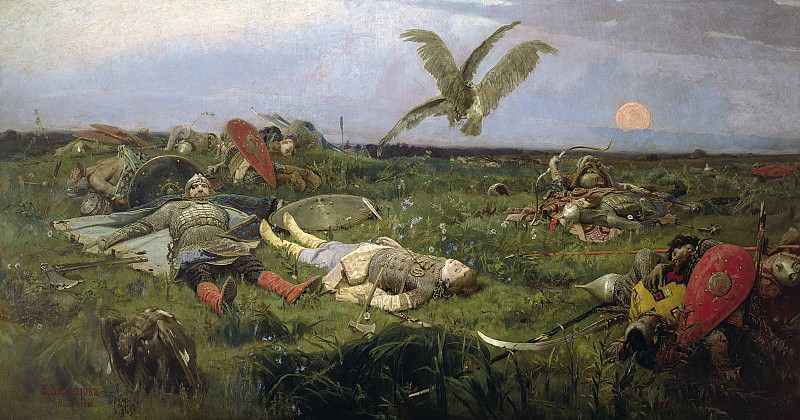After the Battle between Prince Igor Svyatoslavich of Kiev and the Polovtsy Viktor Vasnetsov (1848-1926)
Viktor Vasnetsov – After the Battle between Prince Igor Svyatoslavich of Kiev and the Polovtsy
Edit attribution
Download full size: 2478×1300 px (0,5 Mb)
Painter: Viktor Vasnetsov
Location: The State Tretyakov Gallery, Moscow (Государственная Третьяковская галерея).
Vasnetsov drew the viewer’s attention to the events that took place during the formation of Kievan Rus. However, this painting was painted to show people the courage and bravery of spirit, regardless of the outcome of the war. This painting shows us the events that have become legendary and were recorded in the chronological source called "The Tale of Bygone Years," which was meticulously maintained by Nestor the Chronicler.
Description of Viktor Vasnetsov’s painting "After Igor Svyatoslavich’s Battle with the Polovtsy".
Vasnetsov drew the viewer’s attention to the events that took place during the formation of Kievan Rus. However, this painting was painted to show people the courage and bravery of spirit, regardless of the outcome of the war.
This painting shows us the events that have become legendary and were recorded in the chronological source called "The Tale of Bygone Years," which was meticulously maintained by Nestor the Chronicler. In this collection of feats and military action, found its place and "The Tale of Igor’s Campaign", from the course of literature since high school, everyone knows this tragedy.
Not in vain the artist depicted death and despondency, it makes it clear that even knowing what would be the outcome of the battle, the army of the valiant prince did not surrender and went to his death, sprinkling the ground with blood and sweat. The figures are depicted not in a chaotic order, but in such a way that when they, the Russians, died fighting for the Russian land, they fell with outstretched arms to cover as much of their native land as possible with their bodies. The young man pierced through the heart by an arrow, the mighty bogatyr lying face down on the ground, scattered in an order that only fate alone understands, are well remembered.
The painting is imbued with pride and grandeur. The artist deliberately exalted death to give more passion and faith in the cause one undertakes. This painting served as the impetus for the war effort of the second half of the 19th century. It was an inspiration for military exploits and nobility, patriotism and self-sacrifice.
With his creation he enticed not to be afraid of death, but on the contrary, to go to war with the thought of the end, as something majestic and inevitable, but that it would be for a purpose, with the memories of posterity with admiration. Vasnetsov was not afraid to take the side of the opposition and sacrifice his art for good ideas and goals.
Кому понравилось
Пожалуйста, подождите
На эту операцию может потребоваться несколько секунд.
Информация появится в новом окне,
если открытие новых окон не запрещено в настройках вашего браузера.
You need to login
Для работы с коллекциями – пожалуйста, войдите в аккаунт (open in new window).




















COMMENTS: 2 Ответы
Святая Русь, былинные герои
Красиво, очень не хватает картин на русские национальные мотивы.
You cannot comment Why?
In the sky, two large birds, likely eagles or vultures, soar above the scene, their wings spread wide, their presence a stark symbol of death and the natural order reclaiming the battlefield. In the distance, a large, pale moon or sun is setting, casting a somber, ethereal light over the landscape, adding to the melancholic tone. The overall impression is one of defeat, loss, and the brutal reality of war.
The subtexts of the painting are multi-layered. Primarily, it serves as a powerful anti-war statement, highlighting the tragic consequences of conflict and the devastating loss of human life. The presence of both Russian and Polovtsian warriors, indistinguishable in death, suggests the universality of suffering in war, transcending ethnic and political divides. The predatory birds symbolize the inevitable cycle of life and death, and how nature ultimately endures, indifferent to human struggles. The muted, twilight light and the vast, empty landscape evoke a sense of despair, solitude, and the ephemerality of human glory in the face of vastness and time. The painting may also be seen as a reflection on historical events, potentially intended to evoke a sense of national pride, but also a somber reminder of the costs of such endeavors.